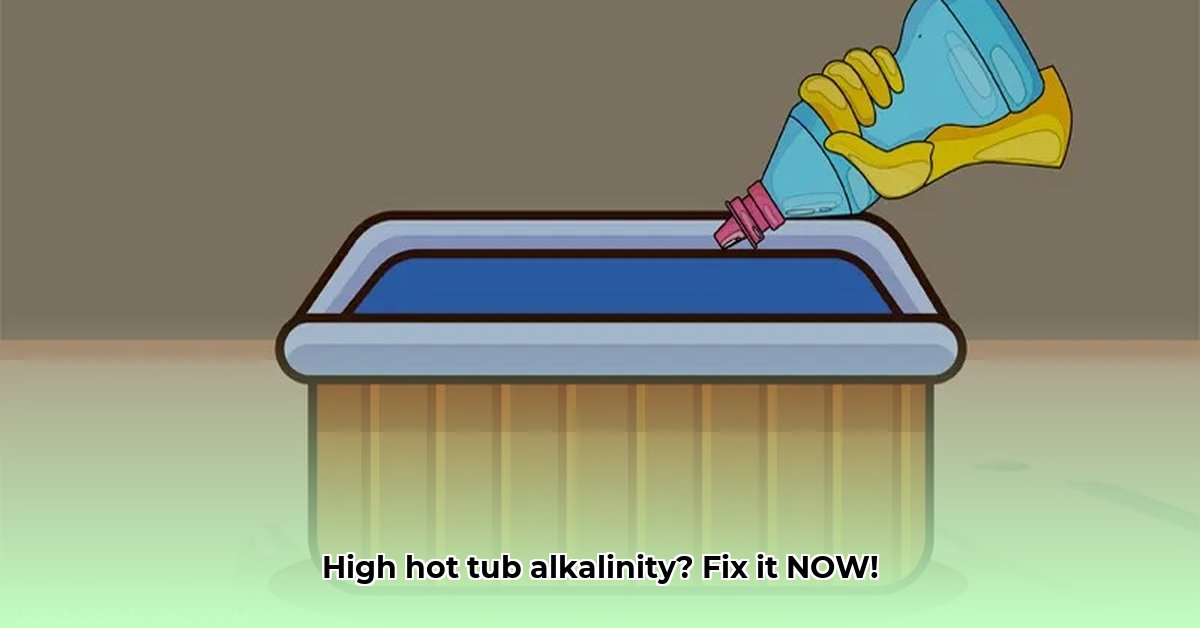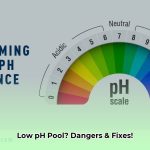High alkalinity can wreak havoc on your hot tub, causing cloudy water, scale buildup, and sanitizer inefficiency. This comprehensive guide provides a step-by-step approach to testing and lowering alkalinity, ensuring crystal-clear, comfortable water.
Understanding the Alkalinity Balancing Act
Think of your hot tub water chemistry as a delicate dance. Alkalinity plays the crucial role of pH stabilizer, preventing drastic fluctuations that can lead to a range of issues. High alkalinity (above 120 ppm) acts like a stubborn buffer, resisting pH adjustments and hindering sanitizer effectiveness. This can create a breeding ground for bacteria, resulting in cloudy, unsanitary water. Additionally, high alkalinity contributes to scale formation, a gritty buildup that roughens surfaces and can eventually damage equipment. It can also irritate skin and eyes, turning a relaxing soak into an uncomfortable experience. Maintaining ideal alkalinity (80-120 ppm) ensures a harmonious balance, promoting clear, clean, and comfortable water.
Testing Your Hot Tub Water: Know Your Baseline
Before adjusting anything, you need to know where you stand. Testing your hot tub water is like taking its temperature—it provides essential information for proper diagnosis and treatment. Several methods are available:
- Test Strips: These offer a quick and easy way to get a general idea of your alkalinity levels. Simply dip a strip into the water and compare the color change to the chart provided.
- Liquid Test Kits: These kits offer greater precision than test strips. They involve adding a reagent to a water sample and comparing the resulting color to a chart.
- Digital Testers: These provide the most accurate readings, displaying the results digitally. While they can be more expensive than other methods, the precision they offer may be worthwhile for those seeking precise control over their water chemistry.
Regardless of your chosen method, always follow the manufacturer’s instructions carefully for accurate results.
Lowering High Alkalinity: A Step-by-Step Approach
Several methods can effectively lower alkalinity, each with its pros and cons:
1. Using Sodium Bisulfate (Dry Acid)
Sodium bisulfate is a common and relatively safe choice for lowering alkalinity. Its ease of use makes it suitable for most hot tub owners.
-
Calculate the Dosage: Use a dosage calculator (many are available online) or refer to the product instructions to determine the correct amount of sodium bisulfate based on your hot tub’s volume and current alkalinity level.
-
Prepare the Solution: Fill a clean, plastic bucket with about a gallon of water from your hot tub. This helps pre-dissolve the dry acid and prevents sudden reactions in the tub. Never add water to dry acid; always add the acid to the water. This precaution helps avoid dangerous splashing and reactions.
-
Mix the Solution: Slowly add the measured sodium bisulfate to the water, stirring gently until fully dissolved.
-
Add to Hot Tub: With the hot tub’s circulation pump running, slowly pour the diluted solution into the tub.
-
Retest and Repeat: After a few hours, retest the water. Repeat the process if necessary, making small adjustments until the alkalinity reaches the desired range.
2. Using Muriatic Acid (Hydrochloric Acid): Proceed with Caution!
Muriatic acid is a more potent option, requiring extreme care due to its corrosive nature. If you’re not comfortable handling strong chemicals, opt for sodium bisulfate or consult a professional.
-
Safety First!: Wear safety glasses and gloves before handling muriatic acid. Ensure adequate ventilation in the area.
-
Calculate the Dosage: Carefully follow the product instructions to determine the precise dosage. Even small miscalculations can have significant consequences.
-
Dilute Carefully: In a clean, acid-resistant bucket (never metal), dilute the muriatic acid. A standard dilution ratio is one part acid to ten parts water, but always double-check the product label. Always add the acid to the water—never the reverse.
-
Add to Hot Tub: Turn off the circulation pump. Slowly pour the diluted acid into the hot tub.
-
Restart Circulation: Wait at least 30 minutes before turning the circulation pump back on.
-
Retest and Repeat: After a few hours, retest the water. Repeat the process carefully if necessary.
3. Natural Alternatives (Vinegar/Lemon Juice)
White vinegar or lemon juice can provide a gentler, albeit less precise, method for minor alkalinity adjustments.
-
Application: Add 1-2 cups of white vinegar or ½-1 cup of lemon juice per 100 gallons of water. The exact amount may vary.
-
Monitoring: Test frequently, as these natural methods may require more frequent adjustments.
| Method | Pros | Cons |
|---|---|---|
| Sodium Bisulfate | Safer, easier to handle, readily available | Slower acting |
| Muriatic Acid | Fast-acting, more potent | Corrosive, requires extreme caution |
| Vinegar/Lemon Juice | Gentler, natural alternative | Less precise, requires frequent adjustments |
The pH Connection: Maintaining the Balance
Adjusting alkalinity often affects pH levels. After lowering alkalinity, test your pH and adjust accordingly. Ideally, pH should fall between 7.2 and 7.8. If it drops too low, raise it using a pH increaser like soda ash (sodium carbonate) or baking soda (sodium bicarbonate).
Proactive Maintenance: Preventing Alkalinity Imbalances
Regularly testing and maintaining your hot tub water, including total alkalinity, is crucial for preventing issues. Aim for testing at least twice a week, especially during periods of heavy use. Covering your hot tub when not in use helps protect the water from contaminants and rain, which can affect alkalinity.
Troubleshooting Persistent Alkalinity Issues
If you consistently struggle with high alkalinity, consider the following:
- Source Water: High alkalinity in your source water can contribute to ongoing issues in your hot tub. A pre-filter for your hose might help reduce these levels.
- Overuse of Chemicals: Using excessive amounts of chlorine or other chemicals can disrupt the water balance, including alkalinity.
- Consult a Professional: If you’ve tried everything and still experience persistent alkalinity problems, consulting a hot tub professional can provide valuable insight and tailored solutions. They can help identify underlying issues and offer specific recommendations for your situation.
By understanding the role of alkalinity, testing regularly, and implementing the steps outlined in this guide, you can maintain crystal-clear, balanced water and maximize the enjoyment of your hot tub for years to come. While this guide provides comprehensive information, individual experiences may vary, and ongoing research continues to refine best practices in hot tub chemistry.
- Memorial Stones for Gardens: A Guide to Creating a Lasting Tribute - April 29, 2025
- Melon Cut Diamonds: A Comprehensive Guide - April 29, 2025
- MarketStreet Lynnfield Stores: A Complete Directory & Shopping Guide - April 29, 2025










